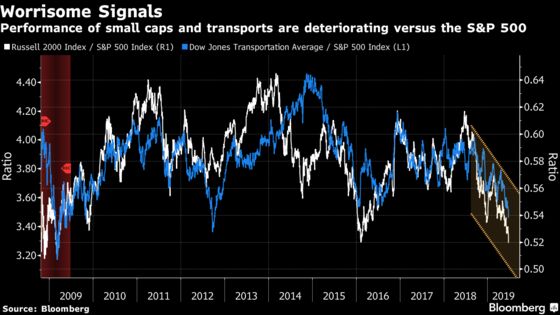Two Groups of Stocks Are About to Send Crisis-Era Signals on the Economy
It’s small caps and transportation stocks, whose performance has deteriorated at a faster clip than other parts of the market.
(Bloomberg) -- The S&P 500 is at a record, but areas of the stock market with a reputation for economic prescience are sending warning signals that hearken to the global financial crisis.
It’s small caps and transportation stocks, whose performance has deteriorated at a much faster clip than other parts of the market. Relative to the S&P 500, each group is on the brink of hitting its lowest point since 2009. For investors, the decline is another example of the growth debate churning underneath the market’s surface.
“There’s still uncertainty as to what direction this market should go. It’s anybody’s guess,” said Jeff Carbone, managing partner at Cornerstone Wealth, which has about $1.3 billion in assets under management. “I just don’t know if we’re out of the woods yet.”

Bears say the weakness in shipping and rail companies that rise and fall with the broader economy and small caps that depend on domestic demand for the bulk of their revenue is a warning not to be ignored. The losses in economically-sensitive stocks reinforce the signal from falling bond yields that suggests all is not well with the economy.
Data Monday added to concern, when an unexpectedly weak factory output from the Dallas Fed was the third such gauge to miss estimates. While the S&P 500 only slipped 0.2%, the Russell 2000 Index sank 1.3%, while the Dow Jones Transportation Average tumbled 1.5%.
For transports, the sell-off added to its worst performance versus the S&P 500 since 2012. Another day like Monday, and the ratio could drop to the lowest in a decade.
FedEx Corp., one of the largest components of the transportation average, reports earnings Tuesday and analysts have warned that trouble looms. Lingering effects from the U.S.-China trade war, the slowdown seen in manufacturing data and weakness in Europe could mean the shipping company will cut guidance for the year-ahead, they say.
Meanwhile, weakness in the Russell 2000 has taken it to the lowest level versus the S&P 500 since 2016, and it sits precariously close to the lowest level since 2009. Weakness in small caps has preceded broader sell-offs in the past. Most recently, the gauge peaked against the S&P 500 in June of last year, foreshadowing the fourth-quarter rout that almost ended the bull market.

“You normally think of small caps as that’s where the dynamic growth of the economy is coming from,” said Peter Jankovskis, co-chief investment officer at Oakbrook Investments. “So to see the overall market doing well while they’re being left behind, it suggests that people are a little bit concerned about growth prospects.”
For Morgan Stanley’s Mike Wilson, one of the most bearish equity strategists on Wall Street, a continuation of soft economic data could lay the groundwork for a 10% correction in the third quarter. As the Fed continues to make the case for data-dependency, the stock market will soon catch on, he said. And if the data continues to worsen, that could mean record highs won’t last long.
--With assistance from Vildana Hajric and Rita Nazareth.
To contact the reporter on this story: Sarah Ponczek in New York at sponczek2@bloomberg.net
To contact the editors responsible for this story: Jeremy Herron at jherron8@bloomberg.net, Chris Nagi
©2019 Bloomberg L.P.